When it comes to emergency weather radios, having the right antenna is crucial for effective reception and communication during critical situations. With the ever-changing weather conditions, it becomes essential to understand what type of antenna is required to ensure the best possible performance. In this article, we will explore the different types of antennas suitable for emergency weather radios and the factors to consider in selecting the ideal one for your needs. Whether you are a seasoned weather enthusiast or a concerned homeowner, this article will equip you with the knowledge to make an informed decision regarding your emergency communication equipment.
Review contents
Importance of a suitable antenna for an emergency weather radio
When it comes to emergency weather radios, having a suitable antenna is crucial. Antennas play a vital role in receiving weather alerts and broadcasts, allowing us to stay informed about potentially hazardous weather conditions such as storms, hurricanes, and tornadoes. Without a proper antenna, an emergency weather radio may not be able to pick up strong and clear signals, limiting its effectiveness in providing timely warnings. Therefore, choosing the right antenna is essential to ensure reliability and accuracy in receiving weather updates.
Factors to consider when choosing an antenna
Frequency range
One of the primary factors to consider when selecting an antenna for an emergency weather radio is the frequency range it can cover. Weather radios typically operate in the VHF (Very High Frequency) and UHF (Ultra High Frequency) bands. It is essential to ensure that the chosen antenna can cover these frequency ranges to receive weather broadcasts without any interruption.
Signal gain and sensitivity
The signal gain and sensitivity of an antenna are important factors that determine its ability to receive weak signals and amplify them for clear reception. An antenna with higher signal gain and sensitivity will provide better reception and coverage, ensuring that critical weather updates are received even in low signal areas.
Directionality
Another factor to consider is the directionality of the antenna. Some antennas are omnidirectional, meaning they can receive signals from all directions, while others are directional, focusing on a particular direction to enhance signal reception. The choice between omnidirectional and directional antennas depends on the specific needs and location of the user. If the weather radio is primarily used in a fixed location, a directional antenna can be beneficial in capturing signals from a specific transmitter tower.
Physical size and aesthetics
The physical size and aesthetics of the antenna are also important considerations. Depending on the location where the emergency weather radio will be used, a compact and visually appealing antenna may be desirable. Additionally, portability might be a factor to consider if the weather radio needs to be used in various locations.
Common types of antennas for emergency weather radios
Whip antennas
Whip antennas are one of the most common types of antennas used with emergency weather radios. These antennas are typically made of a thin, flexible metal rod that can be easily mounted on the radio or extended for better reception. Whip antennas are omnidirectional, allowing them to receive signals from all directions. They are known for their simplicity, versatility, and ease of use.
Telescoping antennas
Telescoping antennas are similar to whip antennas but have the added advantage of being adjustable in length. This adjustability allows users to extend the antenna to a desired length for optimal reception. Telescoping antennas are often found on portable emergency weather radios, providing flexibility and portability. They are also omnidirectional, making them suitable for capturing signals from multiple directions.
Wire antennas
Wire antennas are another popular choice for emergency weather radios. These antennas consist of thin wires that can be easily extended or mounted in various configurations. Wire antennas are known for their simplicity and affordability. They can be installed indoors or outdoors, making them suitable for different situations. Despite being directional, wire antennas can provide reliable signal reception within their coverage area.
Loop antennas
Loop antennas are specialized antennas that are often used in areas with weak signals or significant interference. These antennas consist of a loop-shaped conductor that captures signals through electromagnetic induction. Loop antennas are known for their high directionality and ability to reject unwanted signals. They are particularly effective in reducing interference and enhancing reception in challenging environments.
Whip antennas
Characteristics
Whip antennas are typically made of a thin, flexible metal rod that can range from a few inches to a few feet in length. They are omnidirectional, allowing them to receive signals from all directions. Whip antennas are commonly found on emergency weather radios due to their simplicity, versatility, and ease of use. They can be easily mounted on the radio or extended for better reception.
Pros
One of the main advantages of whip antennas is their ease of installation. They require minimal setup and can be used right out of the box. Whip antennas are also compact, making them suitable for portable emergency weather radios. Additionally, their omnidirectional nature ensures that they can receive signals from all directions, making them a reliable choice in various locations.
Cons
While whip antennas are a popular choice, they do have some limitations. Due to their compact size, whip antennas may have lower signal gain and sensitivity compared to larger antennas. This can result in weaker signal reception in areas with low signal strength. Additionally, whip antennas may not be as effective in heavily obstructed areas or regions with significant interference.
Telescoping antennas
Characteristics
Telescoping antennas are similar to whip antennas but have the additional benefit of adjustability. These antennas consist of a series of nested metal sections that can be extended or retracted to adjust the antenna length. Telescoping antennas are typically found on portable emergency weather radios, providing flexibility and ease of use.
Pros
The adjustability of telescoping antennas allows users to fine-tune the antenna’s length for optimal signal reception. This flexibility is particularly useful in areas with varying signal strength or when the antenna needs to be used in different locations. Telescoping antennas are also omnidirectional, allowing them to capture signals from all directions, ensuring reliable reception.
Cons
While telescoping antennas offer adjustability, their overall size is limited by the radio’s design. This can result in shorter antenna lengths compared to other types of antennas. The shorter length may limit the signal gain and sensitivity, making telescoping antennas less effective in areas with weak signals or interference. Additionally, the nested sections of telescoping antennas can be more prone to damage or wear over time.
Wire antennas
Characteristics
Wire antennas consist of thin wires that can be easily extended or mounted in various configurations. They are known for their simplicity and affordability. Wire antennas can be installed indoors or outdoors, depending on the user’s preference and requirements. They are typically directional antennas with a specific coverage area.
Pros
One of the main advantages of wire antennas is their affordability and accessibility. They can be easily made or purchased at a relatively low cost. Wire antennas also offer flexibility in terms of installation. They can be mounted horizontally or vertically, depending on the desired coverage area. Wire antennas are often used in areas with moderate to strong signal strength, providing reliable reception within their coverage range.
Cons
While wire antennas are cost-effective and easy to install, they have some limitations. As directional antennas, wire antennas are optimized to receive signals from specific directions, which may limit their usability in areas with multiple transmitting towers. Additionally, wire antennas may not be suitable for locations with heavy obstructions or significant interference, as these factors can affect signal reception.
Loop antennas
Characteristics
Loop antennas are specialized antennas that are designed to enhance signal reception in challenging environments. These antennas consist of a loop-shaped conductor that captures signals through electromagnetic induction. Loop antennas are known for their high directionality and ability to reject unwanted signals. They are often used in areas with weak signals or significant interference.
Pros
One of the significant advantages of loop antennas is their ability to reduce interference and reject unwanted signals. This makes them particularly effective in urban areas or regions with high electromagnetic activity. Loop antennas also offer strong directionality, allowing users to focus on specific transmitting towers or sources. They can provide enhanced signal reception in areas with weak signals, making them a suitable choice for emergency weather radios.
Cons
While loop antennas offer excellent interference rejection and directionality, they do have limitations. Due to their specialized design, loop antennas may have a more complex installation process compared to other types of antennas. They may also require additional equipment, such as a preamplifier, to optimize their performance. Additionally, loop antennas may have a larger physical size compared to other antennas, which can affect their portability and aesthetics.
Important considerations for antenna installation
Height and placement
The height and placement of an antenna are crucial factors that can significantly impact its performance. Higher placement of the antenna allows for better line-of-sight to the transmitting tower, reducing obstructions and enhancing signal reception. When installing an antenna, it is important to place it as high as possible and ensure that there are no obstacles, such as buildings or trees, obstructing its path to the transmitting tower.
Grounding
Proper grounding is essential for the safety and performance of the antenna. Grounding helps to dissipate any electrical charges or lightning strikes, protecting both the antenna and the connected equipment. When installing an antenna, it is important to follow best practices for grounding, such as connecting the antenna to a proper grounding system and utilizing surge protectors.
Interference mitigation
In areas with significant interference, it is important to take steps to mitigate the impact on signal reception. This can include using filters or shielding techniques to reduce unwanted signals or noise. Proper antenna placement and orientation can also help minimize interference. It may be necessary to experiment with different locations or antenna types to find the most optimal setup for reliable signal reception.
Elevation considerations
The geographical elevation of the area where the emergency weather radio will be used is an important consideration. In areas with higher elevations, signal reception can be enhanced due to the increased line-of-sight to transmitting towers. On the other hand, areas with lower elevations or surrounded by tall buildings or geographical features may experience more challenges in receiving signals. Understanding the elevation characteristics of the location can help in selecting the appropriate antenna and optimizing its performance.
Maintenance and troubleshooting tips for emergency weather radio antennas
Regular inspection and cleaning
To ensure optimal performance, it is important to regularly inspect and clean the antenna. Inspect the antenna for any signs of damage, such as loose connections or bent elements. Clean the antenna regularly to remove any debris or dirt that can potentially affect its performance. Use a soft cloth or brush to gently clean the antenna without causing any damage.
Checking cable connections
Check the cable connections between the antenna and the weather radio to ensure they are secure and free from corrosion. Loose or improperly connected cables can result in signal loss or poor reception. If necessary, tighten or replace the connectors to maintain a reliable connection.
Replacing damaged parts
If any part of the antenna is damaged or worn out, it is important to replace it promptly. Damaged elements or connectors can significantly impact the antenna’s performance and signal reception. Consult the manufacturer’s instructions or seek professional assistance if unsure about the replacement process.
Dealing with signal loss
If you experience sudden signal loss or a decline in the antenna’s performance, there are a few troubleshooting steps you can take. First, check the antenna’s connections and ensure they are secure. Inspect the antenna for any signs of damage or wear. If necessary, relocate the antenna to a higher position or experiment with different locations to find better signal reception.
Conclusion
Choosing a suitable antenna for an emergency weather radio is essential for reliable and accurate reception of weather alerts and updates. Factors such as frequency range, signal gain, directionality, physical size, and aesthetics need to be considered when selecting an antenna. Understanding the characteristics of common antenna types, such as whip antennas, telescoping antennas, wire antennas, and loop antennas, can help in making an informed decision. Proper antenna installation, including the height and placement, grounding, interference mitigation, and elevation considerations, is crucial for optimal performance. Regular maintenance and troubleshooting tips, such as inspection, cleaning, checking cable connections, replacing damaged parts, and dealing with signal loss, can ensure that the antenna remains in good working condition. By choosing the right antenna and taking proper care, we can maximize the effectiveness of our emergency weather radios and stay prepared for any impending severe weather situations.



























